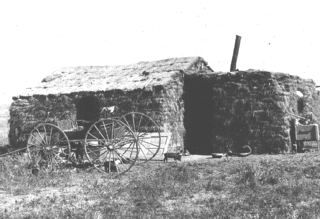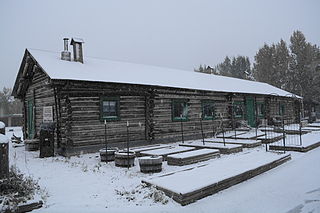Related Research Articles

Harper County is a county located in the U.S. state of Oklahoma. As of the 2010 census, the population was 3,685, making it the fourth-least populous county in Oklahoma. The county seat is Buffalo. It was created in 1907 from the northwestern part of Woodward County, and named for Oscar Green Harper, who was clerk of the Oklahoma Constitutional Convention.

Buffalo is a town and county seat of Harper County, Oklahoma, United States. The population was 1,299 at the 2010 census. It was named after Buffalo Creek Valley, for which it is located.

Buffalo City Hall is the seat for municipal government in the City of Buffalo, New York. Located at 65 Niagara Square, the 32-story Art Deco building was completed in 1931 by Dietel, Wade & Jones.

The sod house or soddy was an often used alternative to the log cabin during frontier settlement of the Great Plains of Canada and the United States. Primarily used at first for animal shelters, corrals and fences, if the prairie lacked standard building materials such as wood or stone, or the poverty of the settlers precluded purchasing standard building materials, sod from thickly-rooted prairie grass was abundant, free, and could be used for house construction. Prairie grass has a much thicker, tougher root structure than a modern lawn. A type in Alaska is a barabara.

The Gibbs Farm is a museum in Falcon Heights, Minnesota, United States. The site was once the farmstead of Heman Gibbs and Jane DeBow, first built in 1854; the existing farmhouse includes the small, original cabin. The museum seeks to educate visitors on the lives of 19th-century Minnesota pioneers and the Dakota people who lived in southern Minnesota before the arrival of Europeans.

The Sod House, which is also known as Marshall McCully Sod House, is a sod house located in Alfalfa County, Oklahoma approximately four miles north of Cleo Springs, Oklahoma.

The Cottonwood Ranch is an historic site near Studley in Valley Township, Sheridan County, Kansas, United States. The ranch is now preserved as a Kansas State Historic Site.

Concrete-Central Elevator is a historic grain elevator located on the Buffalo River at 175 Buffalo River Buffalo in Erie County, New York.

The Sod House Ranch is an historic ranch in Harney County in southeastern Oregon, United States. The remaining ranch structures are located south of Malheur Lake in the Malheur National Wildlife Refuge. The ranch was built by Peter French, a well known 19th-century cattle baron. The Sod House Ranch became the headquarters for the northern operating division of the French-Glenn Livestock Company, which eventually covered over 140,000 acres (570 km2). After French was murdered in 1897, the French-Glenn Livestock Company slowly sold off its ranch property. In 1935, the United States Government purchased the Sod House Ranch property to add to an adjacent wildlife refuge. The eight remaining Sod House Ranch buildings are now listed on the National Register of Historic Places.

The I.O.O.F. Building of Buffalo, in Buffalo, Oklahoma, is an International Order of Odd Fellows building that was built in 1917 in what is now known as Plains Commercial Style architecture. Also known as Harper County Journal Office, the building was listed on the National Register of Historic Places in 1983. It served historically as a meeting hall and as a business.

The Pioneer Sod House in Wheat Ridge, Colorado is a sod house built in 1886 or perhaps well before. It was listed on the National Register of Historic Places in 1973.

The Minor Sod House, also known as Minor Post Office, near McDonald, Kansas, is a sod house that was built c. 1907.

The Wallace W. Waterman Sod House near Big Springs, Nebraska, United States, is a sod house built in 1886. It was modified in 1925 for continued use, including a layer of concrete being applied to the exterior walls. It was listed on the U.S. National Register of Historic Places in 1995. The listing included two contributing buildings, the second being a small outbuilding from 1925.

The William R. Dowse House, more commonly known as the Dowse Sod House, is a sod house in Custer County in the central portion of the state of Nebraska, in the Great Plains region of the United States. It was built in 1900 and occupied until 1959. After a long period of neglect, it was restored beginning in about 1981, and opened as a museum in 1982.

The Walter and Anna Zion Homestead near Idalia, Colorado dates from 1910. It includes sod house architecture. The main house, a "soddy," was built in 1910 by Walter Zion and others. The homestead was listed on the National Register of Historic Places in 2005. The listing included eight contributing buildings, two other contributing structures, and one contributing site in an 1.27-acre (0.51 ha) area.

The Stone Jail Building and Row House are two adjacent stone buildings located on Water Street in Tonopah, Nevada. The jail was built in 1903 and the adjacent row house in 1908. Both building were at one time used as a brothel. The buildings were added to the National Register of Historic Places in 1982.

The Sullivan Roadhouse is a restored historic traveler's accommodation, operated as a museum in Delta Junction, Alaska. The roadhouse was added to the National Register of Historic Places in 1979.

The Henry Roling House is a historic building located northwest of Bellevue, Iowa, United States. It is one of over 217 limestone structures in Jackson County from the mid-19th century, of which 101 are houses. It is similar to most of the other houses in that it is a two-story structure that follows a rectangular plan, has cut stones laid in courses, dressed stone sills and lintel, and is capped with a gable roof. This house differs from most of the others in that it is four bays wide rather than three or five. The Theodore Niemann House a mile west of this one is the oldest of the stone houses in the county, and the Roling house, built shortly after it, is very similar to it. They are similar to the Luxembourgian houses in the region in having an even number of bays, although the Roling house was not stuccoed. The house was listed on the National Register of Historic Places in 1991.

The Harper County Courthouse in Buffalo, Oklahoma, built in 1927, was Harper County's first courthouse building. It was listed on the National Register of Historic Places in 1984.

The Old Settler's Irrigation Ditch, near Rosston, Oklahoma, in both Beaver County, Oklahoma and Harper County, Oklahoma, was constructed during 1893 to 1905. It was listed on the National Register of Historic Places in 1983.
References
- 1 2 "National Register Information System". National Register of Historic Places . National Park Service. November 2, 2013.
- 1 2 Karen Bode Curths; Mary Ann Anders (September 1982). "National Register of Historic Places Inventory/Nomination: Page Soddy". National Park Service . Retrieved June 15, 2018. With accompanying three photos from 1982
| This article about a property in Oklahoma on the National Register of Historic Places is a stub. You can help Wikipedia by expanding it. |